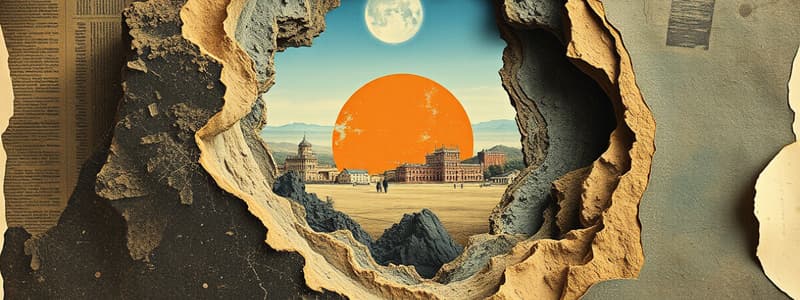Podcast
Questions and Answers
How do geologists learn about Earth's interior?
How do geologists learn about Earth's interior?
- Only through direct evidence from rock samples
- Only through indirect evidence from seismic waves
- Through both direct evidence from rock samples and indirect evidence from seismic waves (correct)
- None of the above
What do rock samples provide to geologists?
What do rock samples provide to geologists?
Clues about Earth's structure and conditions deep inside.
What produces seismic waves that geologists study?
What produces seismic waves that geologists study?
- Meteor impacts
- Earthquakes (correct)
- Volcanic eruptions
- Human activities
What are the three main layers of Earth?
What are the three main layers of Earth?
What is pressure in the context of Earth's interior?
What is pressure in the context of Earth's interior?
What is the outer layer of Earth's skin called?
What is the outer layer of Earth's skin called?
What is ocean crust primarily composed of?
What is ocean crust primarily composed of?
What type of rock is basalt?
What type of rock is basalt?
What is continental crust made up of?
What is continental crust made up of?
What is granite?
What is granite?
What is the mantle's state?
What is the mantle's state?
What is the lithosphere?
What is the lithosphere?
What characterizes the asthenosphere?
What characterizes the asthenosphere?
What occurs in the mesosphere?
What occurs in the mesosphere?
What two parts make up the core?
What two parts make up the core?
What is the outer core's composition?
What is the outer core's composition?
What is the inner core?
What is the inner core?
What creates Earth's magnetic field?
What creates Earth's magnetic field?
Flashcards are hidden until you start studying
Study Notes
Understanding Earth's Interior
- Geologists study the Earth's interior using direct evidence from rock samples and indirect evidence from seismic waves.
- Rock samples are obtained through drilling, providing insights into the Earth's structure and conditions at various depths.
Evidence Collection
- Seismic waves generated by earthquakes are recorded and analyzed by geologists to infer information about the Earth’s layers.
Earth's Layers
- The Earth is composed of three main layers: the crust, mantle, and core.
- These layers differ significantly in size, composition, temperature, and pressure.
Pressure and Temperature
- Pressure increases with depth due to the weight of overlying rock, leading to higher temperatures in the Earth's interior.
Crustal Layers
- Crust: The Earth's outer skin made of solid rock, including land and ocean floor.
- Ocean Crust: Found beneath oceans, primarily composed of basalt and ocean sediment.
- Continental Crust: Forms continents and consists of diverse rock types, primarily granite.
Rock Types
- Basalt: A dark, fine-grained volcanic rock that forms the ocean crust.
- Granite: A light-colored, coarse-grained igneous rock that characterizes the continental crust.
The Mantle
- The mantle, nearly 3,000 kilometers thick, is made of hot, solid rock divided into layers based on physical properties.
- Lithosphere: The brittle uppermost part of the mantle combined with the crust, characterized by strong rock.
- Asthenosphere: Located beneath the lithosphere, it is less rigid and hotter, under increased pressure.
- Mesosphere: Below the asthenosphere, this layer is hot yet more rigid due to higher pressure, including the transition zone and the lower mantle.
The Core
- Composed primarily of iron and nickel, divided into:
- Outer Core: A layer of molten metal surrounding the inner core, causing it to be liquid.
- Inner Core: A dense, solid metal ball where extreme pressure prevents iron and nickel from becoming liquid.
Earth's Magnetic Field
- Movements in the liquid outer core generate Earth's magnetic field, causing the planet to act like a giant magnet affecting its environment.
Studying That Suits You
Use AI to generate personalized quizzes and flashcards to suit your learning preferences.




